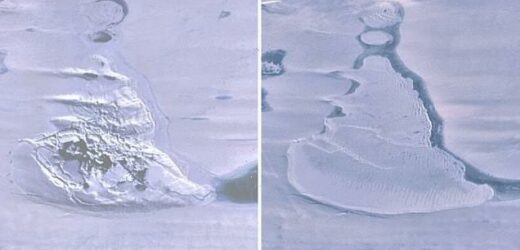Huge Antarctic lake has suddenly DISAPPEARED: Body containing up to 750 million cubic metres of water is lost to the ocean after draining in less than a week, radar images reveal
- Researchers report sudden demise of the large, deep, ice-covered Antarctic lake
- The vast weight of meltwater in the deep lake cracked open the ice shelf beneath
- Meltwater is from melted snow or ice and – and can be caused by climate change
A huge ice-covered lake in East Antarctic disappeared in less than a week, potentially due to climate change, a new study reveals.
Researchers used radar images to track the rapid melting event at the Amery Ice Shelf, which occurred in June 2019, during the Antarctic winter.
Scientists believe the weight of meltwater (water released by the melting of snow or ice) accumulated in the deep lake and cracked open the ice shelf beneath – an event called a ‘hydrofracture’.
It’s estimated that between 600 million and 750 million cubic metres (21-26 billion cubic feet) of water drained to the ocean below – about twice the volume of San Diego Bay.
Landsat 8 images over the Southern Amery Ice Shelf show the ice-covered lake before drainage (left) and the resulting ice doline – or depression – with summer meltwater (right)
WHAT IS AN ICE SHELF?
Ice shelves are permanent floating sheets of ice that connect to a landmass.
Most of the world’s ice shelves hug the coast of Antarctica.
However, ice shelves can also form wherever ice flows from land into cold ocean waters, including some glaciers in the Northern Hemisphere.
Source: National Snow and Ice Data Center
After drainage, in place of the lake, there was a crater-like depression in the ice shelf surface, covering about 4.25 square miles.
This surface depression, known as an ice ‘doline’, contained the fractured remains of the ice cover.
‘We believe the weight of water accumulated in this deep lake opened a fissure in the ice shelf beneath the lake, a process known as hydrofracture, causing the water to drain away to the ocean below,’ said study author Roland Warner, a glaciologist with the Australian Antarctic Program Partnership at the University of Tasmania.
The team can’t say for sure what triggered the rapid draining event.
It is too early to conclude that the drainage of this meltwater lake was related to the warming of the climate around Antarctica, they say.
But it’s well known that rising air temperatures melts ice shelves, increasing the risk of widespread hydrofracturing.
Greenhouse gas emissions from human activities cause a rise in global temperatures, which in turn melt ice and snow and result in a rise in sea levels.
These human activities include burning fossil fuels such as coal, natural gas and oil, which release carbon dioxide (CO2), a greenhouse gas, as well as deforestation.
Scientists have previously predicted that sea levels will rise to such an extent within this century that entire cities will be submerged due to greenhouse gas emissions, forcing millions of people to evacuate their homes.
‘Surface melting over Antarctica’s floating ice shelves is predicted to increase significantly during coming decades, but the implications for their stability are unknown,’ the team say in their paper.
For their study, researchers used images from Landsat 8, a radar satellite that can ‘see’ during the polar night to pin the event’s timing down to a week or less in June.
The event was also captured by a green-light laser instrument on NASA’s ICESat-2, which transmits pulses of photons and accurately locates the reflection point of each photon it receives back from Earth.
Photo courtesy of the Australian Antarctic Division shows a ‘loose tooth’ – or rift in the ice – on the Amery Ice Shelf in eastern Antarctica
Antarctica is home to a number of ice shelves, including Amery. The formations are also found along Arctic coastlines
Repeat orbits of ICESat-2 on the exact ground tracks before and after the lake drainage revealed the vertical scale of the disruption.
‘It is exciting to see ICESat-2 show us details of processes that are occurring on the ice sheet at such fine spatial scale,’ said co-author Helen Amanda Fricker, a glaciologist at Scripps Institution of Oceanography.
‘Since surface meltwater on ice shelves can cause their collapse which ultimately leads to sea-level rise when grounded ice is no longer held back, it’s important to understand the processes that weaken ice shelves.’
The future of the newly formed ‘doline’ is uncertain, the scientists say, although it may accumulate meltwater again or drain to the ocean more frequently.
The hydrofracture process has been implicated in the collapse of smaller ice shelves in the Antarctic Peninsula, where meltwater forms on the surface of ice shelves during the Southern Hemisphere’s summer.
But it is not often seen driving through ice as thick as the 1,400 meters (4,590 feet), as observed at this location on Amery Ice Shelf.
The study has been published in Geophysical Research Letters.
SEA LEVELS COULD RISE BY UP TO 4 FEET BY THE YEAR 2300
Global sea levels could rise as much as 1.2 metres (4 feet) by 2300 even if we meet the 2015 Paris climate goals, scientists have warned.
The long-term change will be driven by a thaw of ice from Greenland to Antarctica that is set to re-draw global coastlines.
Sea level rise threatens cities from Shanghai to London, to low-lying swathes of Florida or Bangladesh, and to entire nations such as the Maldives.
It is vital that we curb emissions as soon as possible to avoid an even greater rise, a German-led team of researchers said in a new report.
By 2300, the report projected that sea levels would gain by 0.7-1.2 metres, even if almost 200 nations fully meet goals under the 2015 Paris Agreement.
Targets set by the accords include cutting greenhouse gas emissions to net zero in the second half of this century.
Ocean levels will rise inexorably because heat-trapping industrial gases already emitted will linger in the atmosphere, melting more ice, it said.
In addition, water naturally expands as it warms above four degrees Celsius (39.2°F).
Every five years of delay beyond 2020 in peaking global emissions would mean an extra 20 centimetres (8 inches) of sea level rise by 2300.
‘Sea level is often communicated as a really slow process that you can’t do much about … but the next 30 years really matter,’ lead author Dr Matthias Mengel, of the Potsdam Institute for Climate Impact Research, in Potsdam, Germany, told Reuters.
None of the nearly 200 governments to sign the Paris Accords are on track to meet its pledges.
Source: Read Full Article





